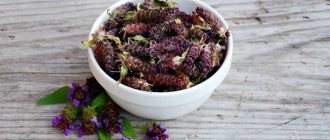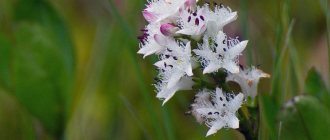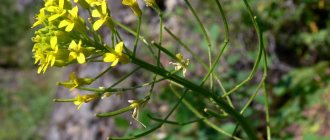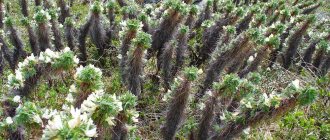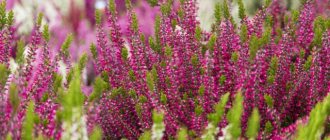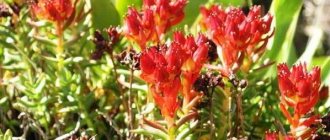Where does Wormwood grow?
Wormwood is not fussy; having a long main root, it can grow even in arid areas. Widely distributed in Russia. Often found in North and South America, Africa, and Eastern countries.
Wormwood is so diverse that 170 species grow in Russia alone. In areas with more favorable conditions, the height of wormwood can be up to two meters in height.
Harvesting wormwood for a bath
Wormwood for baths is harvested during the flowering period, because the plant accumulates the most useful substances at this time.
To do this, cut off the flowering leafy tips of shoots up to 25 cm long.
Wormwood is dried in bunches, hanging with the tops down. And during bath procedures, these bunches are hung in different places in the room, and then they begin to release phytoncides and essential oils in the hot and humid air.
Baths made from bitter wormwood are recommended for the treatment of gout and articular rheumatism. To do this, approximately one kilogram of wormwood is boiled in a bucket of water and poured into the bath.
The smell of wormwood raises vitality, restores strength, and improves mood.
What does Wormwood look like?
Wormwood is a perennial plant that looks like a small shrub. From the very root, four or five thick branches grow upward, and 7-8 thin ones. The lushness of the Wormwood bush depends on the soil.
The leaves of Wormwood are of various shapes; at the bottom of the stem they are single and large, and at the top the stem is divided into many branches along which small leaves are distributed. If you look at Wormwood from afar, it seems fluffy.
The color of Wormwood depends on the type; the stems of Artemisia are dark gray in color, and the leaves are silvery. Other species have light green stems, and the leaves may be almost white on the inside and silver-green on the outside.
Wormwood flowers are yellow and look like balls collected in small baskets.
In what cases is it worth treating with bitter herbs? Can it be used for oncology?
Vitamins, microelements, essential oils, organic acids and much more - the chemical composition of wormwood is rich and varied. Thanks to this, the herb is useful for many ailments:
- Helps cope with gastrointestinal disorders, improves digestion, and relieves flatulence.
- Treats various diseases of the liver, gall bladder, kidneys.
- It has anti-inflammatory properties, therefore it is used in gynecology.
- It rids the body of parasites (it’s not without reason that one of its names is “wormworm”).
- Stimulates the activity of the heart, helps with hypertension.
- Calms, fights insomnia, slightly reduces blood pressure.
- Relieves seizures in epilepsy.
- Effective for migraines, painful menstruation, hemorrhoids.
- Stimulates appetite.
A special time is chosen for harvesting wormwood. - Treats bronchial asthma.
- Helps cope with tuberculosis, cholera, malaria.
- Fights depression and fatigue.
- Improves metabolism.
- Helps normalize body temperature.
- Relieves the condition of rheumatism and inflammation of the joints.
- Suitable for treating burns, bruises, ulcers, eczema, herpes, etc.
Of course, to treat such various diseases, wormwood is used in several medicinal forms, making them:
- tinctures, including alcoholic ones;
- decoction;
- tea;
- powder;
- juice;
- ointment;
- oil.
Wormwood is often used in enemas and douching, tampons are soaked in it, and compresses are made. This herb is believed to help in the fight against cancer. Scientists believe that the “annual wormwood” variety has these properties to a greater extent. At the same time, in folk medicine, wormwood is actively used for the prevention of cancer. And for uterine fibroids (benign tumors), herbalists prescribe it as a treatment.
Attention! Tea with wormwood is drunk without sugar, because it can reduce the effectiveness of the medicine.
When to collect and prepare Wormwood
Wormwood is collected just at the time of flowering, then its beneficial properties are at their peak. If you need grass seeds, they begin to ripen in late August early September. Ripe seeds are gray in appearance, oblong and without tufts.
Wormwood should be dried in a dark place without strong wind. It can be tied in small bunches and hung in the attic. And spread it out, in a thin layer under a covered building, and turn it over from time to time.
Direct sunlight can dry out the grass and it will lose its healing properties.
How to prepare wormwood
The leaves and grass of wormwood are harvested for medicinal purposes. Harvesting is done during budding and the beginning of flowering. It is better to harvest raw materials in the third phase of the Moon, in the evening, after dew, after sunset.
Remove leaves without petioles by hand. The tops of the shoots (grass) can be cut off up to 25 centimeters with a knife or scissors. You need to dry the raw materials outdoors, in the shade, in a ventilated area.
You can use a dryer for drying, but the oven temperature should not exceed 50°C to prevent the essential oils from evaporating. The raw material is considered dried when the stems break. In good weather, wormwood dries out within a week. Store the herb in tight bags or wooden boxes for no more than two years.
Medicinal plants. Large illustrated encyclopedia This book is unique.
- This is also a guide to plants, both wild and cultivated, that can be used for medicinal purposes, as it contains their visual photographs and full characteristics.
- And a herbalist - thanks to a variety of recipes used for the most common diseases, with precise dosages and a detailed description of the preparation process.
- And a guide to collecting and preparing medicinal herbs.
- And even a guide to growing and caring for cultivated medicinal plants.
The author of this encyclopedia is T.A. Ilyina, a candidate of biological sciences, summarized her own experience and professional knowledge. Buy the electronic version Buy the paper version
Healing properties of Wormwood
There are so many beneficial microelements in this herb, here are some of them:
- Absinthine;
- Flavonoids;
- Pinen;
- Provitamins of group A;
- Alkaloids;
- Phytoncides;
- Malic and succinic acid;
- Carotene;
- Tannins and much more.
Drinking decoctions of Wormwood, thanks to its galenic substances, improves the reflex system, helps improve the outflow of bile, improving digestion.
Wormwood essential oil restores the functioning of the central nervous system. Of course Wormwood tastes bitter, no matter what you can do for your health, you can tolerate the bitterness.
Wormwood is very good for cleansing the body and removing many parasites that live at our expense; it is because of them that many chronic diseases begin, such as heart failure or kidney failure, ulcers and gastritis.
Qualitative composition of wormwood
The composition of wormwood surprises with its richness of elements beneficial to humans.
- The bitter taste appears due to glycosides. These compounds have antiparasitic and antifungal properties, improve the flow of bile, and normalize digestion.
- The effect of essential oils is similar to that of camphor. The work of the heart muscle is stimulated and the nervous system is excited.
- The flavonoids include the natural antibiotic artemisetin. It is destructive to Escherichia coli and Pseudomonas aeruginosa, relieves inflammation, and prevents bacteria from developing. I attribute anti-cancer properties to this substance.
- Under the influence of resinous and tannin substances, blood clotting increases and wounds heal faster. The fight against infections becomes more effective, and gastric disorders no longer bother you.
- The presence of organic acids helps eliminate toxic substances, normalizes the activity of the nervous system and brain functions, and helps regulate acidity levels.
- Wormwood includes a complex of minerals and vitamins important for health: zinc, calcium, magnesium, selenium, bromine, vitamins C, B, A.
Uses of Wormwood
To cleanse your body with Wormwood decoctions, especially women, you should try this recipe:
- One tablespoon of Wormwood per glass of boiling water, leave for 10 minutes and drink morning and evening, for three days, once a month or two.
— A recipe for how to get rid of worms and other parasites; crushed powder of Wormwood, cloves and flax seeds, take half a teaspoon of each ingredient. Mix everything and put half a spoon of the dry mixture in your mouth and wash it down with a glass of carrot juice. This way you will get rid of not only parasites, but also their eggs.
— Crushed Wormwood herb is good for relieving swelling, for example, during a sprain. Once you apply it to the damaged area, the pain will immediately subside and the swelling will gradually resolve.
- Decoctions of wormwood are excellent for asthma or rheumatism.
— If Wormwood is used in combination with other medicines or herbs, then even diseases such as tuberculosis, hypertension, fever, various edema, and hemorrhoids are treated.
— Prepared ointments based on Wormwood relieve burns, fistulas and various skin ulcers.
There are many folk recipes, it all depends on your illness.
Moneybox of knowledge
You can buy wormwood herb at a pharmacy, or you can prepare it yourself. In this short chapter I will talk about how to properly grow, collect and store plants. Procurement is a serious matter. The quality of raw materials depends on compliance with the procurement rules, and this is half the success in healing. Before you start collecting, you need to know exactly for what purpose the raw materials are being harvested and which parts of the plant are to be harvested. You only need to collect those parts that will be used later.
Herbs are collected at a strictly defined period of their development (during the opening of leaves or flowers, flowering, fruiting, at the beginning or end of the growing season), when the content of valuable substances in individual organs is the highest. Plants (or their parts) are used in cosmetics both fresh and dried. The above-ground parts of plants are usually harvested in dry weather - wet raw materials deteriorate when dried. The seeds of some herbs (for example, Chernobyl), on the contrary, are best collected slightly unripe and early in the morning, in the dew, since at this time they do not fall off. Rhizomes can be dug up in any weather, because they still have to be washed before drying.
You cannot collect herbs (as well as mushrooms and berries) within the city, especially near roads with busy traffic. Harmful components of exhaust gases gradually accumulate in the soil and pass into plants. Preparations made from such raw materials can have a completely opposite effect instead of a therapeutic one. For the same reason, plants that are heavily contaminated or damaged by diseases and pests should not be harvested. When collecting, care must be taken not to damage the plant itself (if only leaves or flowers are collected). If wild annual plants are harvested, then it is necessary to leave some of them for seeds. The above-ground parts of plants that reproduce by rhizomes can be cut off completely, but the underground organs must not be damaged. When collecting roots and rhizomes, it is also necessary to leave some of the plants for propagation.
The collected raw materials are cleaned of impurities and drying begins no later than 1-2 hours after collection. Plants (except roots and rhizomes) should not be washed. The raw materials are laid out in a thin layer on a mat and air-dried in a shaded place - under a canopy, in the attic, in a stove, oven or dryer. Most plants should not be dried in the sun. The grass is often dried by tying it into small bunches and hanging it in shaded areas. Fruits and seeds are dried in the sun, as well as bark, roots and rhizomes. However, odorous roots and rhizomes are dried in the shade or in a well-ventilated area. Before drying, long roots are cut across, thick ones - lengthwise, and very thick ones are cut into circles.
Drying is considered complete if the leaves and flowers are easily ground into powder, the stems and roots break rather than bend, and the fruits do not stick together. Well-dried raw materials should not lose their natural color. Store it in paper bags, pouches, drawers and boxes lined with paper on the inside in clean, dry, cool places with good ventilation. Plants containing essential oils should be stored in glass containers with a ground stopper or in metal jars with a tight-fitting lid. Scented plants should be kept separate from non-scented ones. When packaging raw materials in bags, jars or other containers, labels with the name of the plant and the time of collection are placed inside. Typically, the shelf life of flowers, leaves and grass does not exceed 1-2 years, fruits - 2-3 years. The bark, roots and rhizomes can be stored for 3-5 years. However, at home it is not always possible to provide optimal storage conditions (temperature, air humidity). In this case, it is not recommended to store raw materials for more than a year.
Plants are among the most sensitive living organisms on Earth. Their energy reacts almost instantly to any changes in the environment - the change of seasons, lunar phases, days and nights, the transition of the Sun and Moon from one zodiac sign to another.
Astrologers claim that the energy, and therefore the healing properties of herbs are not the same on different days of the lunar calendar. So, 9, 15, 23, 26, 29 lunar days are unfavorable, and at this time you should neither harvest herbs nor prepare potions from them. The most favorable days for these purposes are considered to be 5, 8, 12, 13, 16, 24 days. In addition to the phases of the Moon and the position of the Sun in the signs of the Zodiac, the weekly rhythm should be taken into account. Each day of the week is associated with one of the septenary planets (Sun, Moon, Mercury, Venus, Mars, Jupiter, Saturn). By collecting plants, you can enhance their energy at the expense of the planet. Thus, Thursday is associated with Jupiter, Friday with Venus, Saturday with Saturn, Sunday with the Sun, Monday with the Moon, Tuesday with Mars, Wednesday with Mercury.
In addition to the energy of the Earth, plants have the energy of the planets that they control. So, for example, fragrant plants that turn towards the Sun correspond to the Sun; with leaves and flowers closing at sunset. Among them is wormwood. Mars rules plants that are bitter, moderately poisonous, with thorns and prickles, and sometimes with a pungent odor. Among them, of course, wormwood is an unsurpassed bitterness. She is also a plant ruled by Saturn (constellation Capricorn). Speaking about a favorable time for collecting herbs, one cannot fail to mention the day of Ivan Kupala - the summer solstice holiday. In mythology, this holiday is associated with the purification of man and nature by the elements of Fire and Water. At this time, the Sun is as close as possible to the Earth, and all life on it, including grass, has the greatest energy power.
When collecting herbs, ethical rules must also be observed. Do not collect plants in large quantities; in no case take more than you need. Working with herbs requires unconditional respect for nature, recognition of its power and treating it as a living, intelligent being. So, preserving the healing properties of a picked plant depends on several conditions: it must be collected at the appropriate phase of plant development, in a suitable place, on a favorable day and time of day, in compliance with ethical standards.
Now let's briefly look at the features of collecting and drying various types of wormwood. Wormwood grass is harvested at the beginning of flowering, that is, in June-July, cutting off the flowering tips of the shoots without rough parts of the stem with a sickle or knife. Leaves, on the contrary, are collected before flowering begins - in early May and June. It must be remembered that delays in harvesting lead to a decrease in the medicinal value of the plant. To prevent the grass from darkening, place it in a basket loosely, loosely, and then lay it out in the attic or under a canopy in a layer of 3-5 cm. This way it will dry faster. It should be stored in thick linen bags or in wooden containers for 2 years. The yield of dry raw materials is about 25%.
In common wormwood, leaves and roots serve as medicinal raw materials. They are harvested in the same way as wormwood: for medicinal and food purposes, young leaves and tops of stems are plucked at the beginning of summer, before they become too bitter. The flowering tops are harvested in July. The raw materials are dried in the shade or in a well-ventilated area. Chernobyl twigs can be dried in bunches, tied into small brooms and hung in the attic under the rafters. The roots of wormwood are collected in the fall. The soft, fleshy parts are separated from the main root and dried, without washing, under a canopy or in a dryer at a temperature of 50-60 C. As they dry, the grains of sand fall off. The roots are stored in a wooden container for no more than 3 years.
Read about this topic on the website:
Wormwood in magic and folklore Growing wormwood on the plot and in the garden Recipes for dishes with the addition of wormwood Wormwood in cooking Recipes from wormwood Wormwood in alternative medicine recipes The use of wormwood for skin diseases
Wormwood - contraindications
The main prohibitions on the use of Wormwood for:
- Pregnant women and during feeding;
- Serious gastrointestinal diseases;
- Various allergic reactions and intolerance to the components of wormwood;
- Suffering from anemia;
- For poor blood clotting and similar diseases.
You should be careful and not exceed the course of treatment of 14 days, because Wormwood is also poisonous. Do not exceed the dose, and take mandatory breaks between courses of at least two weeks.
Application, benefits and medicinal properties of bitter wormwood
Bitter wormwood is one of the most accessible, natural and effective remedies that can overcome many diseases, infections and improve the health of the body.
Why is wormwood needed in the home and in medicine? This herb is one of the best in the fight against serious diseases such as cancer and oncology. Pests to the body such as worms, viruses, and various types of fungi cannot resist its healing power.
There are various microorganisms in the body of every person, and gradually acting, they slowly but surely “kill” the body. This subsequently leads to various severe and chronic diseases.
The effect of such parasites has a detrimental effect on the digestive system and sexual activity of men. These parasites also have a negative effect on the body, and because of them, oncology and various types of papilloma occur.
The use of wormwood is recommended for the following diseases:
- Disturbed metabolism.
- For diseases associated with the liver and bile ducts.
- Skin diseases (allergies, eczema, etc.).
- For diseases with active secretion of mucus and pus.
It is also a preventative against heart attack.
This herb is very effective in strengthening the immune system and overall health of the body. It is recommended to take it for preventive purposes.
It is important to note that in order for all the properties of a wild plant to be effective, it must be properly collected, prepared and stored.
Where does wormwood grow?
The diversity of wormwood species can be explained by the fact that the grass easily spreads across areas and territories, easily adapting to new weather and climatic conditions, soil, expanding its horizons.
Today, wormwood can be found by humans both in the form of a bush and in the form of field grass.
If we talk about Caucasian wormwood, it can be found on the arid mountains and steppes of Crimea. The grass has adapted perfectly to mountain frosts and winters. Despite this, wormwood survives the dry, hot seasons of the Don region very well.
Many modern lovers of plants and flowers, thanks to the decorative properties of wormwood, grow it in their flower beds.
But it is the wormwood that will always grow alone, since not a single plant can live and grow near it. This plant is grown in a separate area.
Common wormwood is found mainly in the middle zone. The plant is so unpretentious to living conditions that it can grow en masse in wastelands, near highways and roads, in abandoned areas and landfills, slopes and where the soil consists of limestone soil.
Wormwood is a perennial plant, gaining a height of up to 100 cm. It is easy to recognize and distinguish from other types of wormwood; it has slightly ribbed stems that begin to branch only at the very top.
In turn, at the base you can find small shoots, which have characteristic features - triple-pinnately dissected long-petioled leaves. If you rise higher, in the middle of the plant there will already be double-pinnately dissected short-petioled leaves, and at the very top there will be tripartite or completely whole leaves.
The flowering of wormwood involves the development of yellowish spherical flower baskets, which are distinguished by some drooping inflorescences. Wormwood bears fruit by achene from June to August.
What are the beneficial properties of wormwood herb?
The bitter herb wormwood has the following healing and pharmacological properties:
- anticonvulsant;
- secretory;
- blood purifying;
- carminative;
- soothing;
- anti-inflammatory;
- painkiller;
- antitumor;
- antiseptic;
- anthelmintic;
- appetizing;
- diuretic.
The chemical composition includes the following valuable substances:
- essential oil, which includes ketone, thujone, pinene, phellandrene;
- bitterness: absinthine, artabsin;
- tannins.
Types of wormwood
Wormwood prepared for the bath comes in different types, each of them can have a different effect on the body. It can be:
- lemon;
- medicinal;
- paniculata;
- bitter.
Lemon wormwood
A plant of this species has an expectorant and analgesic effect, and it also has a positive effect on the blood supply to the heart muscles. For women, it is useful in that it can normalize the menstrual cycle and relieve severe headaches and fever.
Medicinal wormwood
This wormwood can stabilize the digestive system, positively influencing the production of gastric juice and pancreatic enzymes. It also has an excellent choleretic effect.
paniculata
Paniculata has a diuretic property, and the essential oil prepared from it has a laxative property. This plant is also effective in the treatment of radiculitis, and women can use it to normalize the menstrual cycle and make it less painful.
Wormwood
It contains bitter glycosides, which give it a characteristic taste. This plant is able to normalize the functioning of the gastrointestinal tract, positively affecting all organs, and also effectively fight pathogens of fungal infections.
